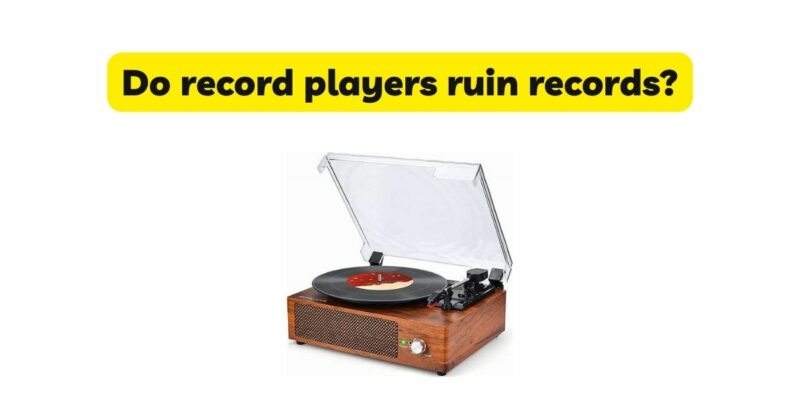The resurgence of vinyl records has captivated music enthusiasts worldwide, reigniting a passion for the warm and authentic sound that analog playback provides. As more people embrace vinyl as a medium for music enjoyment, concerns about the potential damage caused by record players have surfaced. In this article, we will delve into the question, “Do record players ruin records?” and explore the various factors that can affect vinyl preservation when using turntables. By understanding these factors, we can make informed decisions and adopt practices to ensure the longevity of our cherished vinyl collections.
- The Mechanisms of Vinyl Record Playback
To understand the impact of record players on vinyl records, it is crucial to familiarize ourselves with the mechanisms involved in the playback process. A vinyl record consists of grooves that contain the audio information. A turntable’s stylus, attached to the tonearm, traces these grooves, converting the analog audio signals into sound waves that are then amplified and played through speakers. It is within this intricate interplay that potential risks to record integrity may arise.
- Debunking the Myth of Record Players Ruining Records
Contrary to popular belief, not all record players inherently ruin records. While it is true that certain factors can contribute to wear and tear over time, it is important to differentiate between the potential risks associated with specific turntables and the broader perception that all record players are damaging to vinyl. By understanding these factors, we can make informed choices and take measures to mitigate any potential risks.
- Factors Affecting Record Preservation
Several factors can impact vinyl record preservation when using record players. Let’s explore these factors in detail:
a. Tracking Force: The tracking force, or the pressure exerted by the stylus on the record’s grooves, is crucial for accurate playback. Insufficient tracking force can cause the stylus to skate across the surface, resulting in distorted sound and potential damage to the grooves. Conversely, excessive tracking force can exert unnecessary pressure, causing excessive wear and damage. Properly adjusting and calibrating the tracking force according to the cartridge manufacturer’s recommendations is crucial for minimizing the risk of damage.
b. Tonearm Alignment: The alignment of the tonearm is another critical factor in preserving vinyl records. Misalignment can result in uneven tracking force distribution across the grooves, leading to premature wear and distortion. Regular alignment checks and adjustments using alignment protractors or professional assistance can help maintain optimal playback conditions.
c. Cartridge Quality: The cartridge, which holds the stylus, plays a significant role in playback accuracy and record preservation. Low-quality cartridges may have poorly designed styli or inadequate tracking capabilities, which can cause excessive wear or damage to the grooves. Investing in high-quality cartridges that match your turntable’s specifications and regularly replacing worn styli is essential for minimizing risks.
d. Dust and Dirt: Dust and dirt particles are common enemies of vinyl records. When these particles accumulate on the record’s surface, they can create friction and potentially damage the grooves during playback. Regular cleaning using appropriate record cleaning brushes, microfiber cloths, or record cleaning machines can help prevent debris buildup.
e. Environmental Factors: Environmental conditions can also impact record preservation. Excessive heat, humidity, and exposure to direct sunlight can cause warping, mold growth, and deterioration of vinyl records. Storing records in a cool, dry, and dust-free environment can help mitigate these risks.
f. Playback Frequency: The frequency of playback can affect the longevity of vinyl records. Frequent playback increases the wear and tear on the grooves. While playing records should be enjoyed, exercising moderation and not excessively subjecting records to playback can help preserve their condition.
- Preservation Techniques for Record Care
To ensure the longevity of vinyl records, it is crucial to adopt proper preservation techniques. Here are some practices to consider:
a. Store Records Vertically: Storing records vertically in sturdy record shelves or storage units helps prevent warping and reduces the risk of dust settling on the surfaces.
b. Use Inner Sleeves: Replace original paper or cardboard inner sleeves with high-quality anti-static polyethylene or polypropylene sleeves. These sleeves offer better protection against dust, reduce static buildup, and prevent scratching.
c. Handle Records Properly: Always handle records by their edges to avoid touching the playing surface. Fingerprints, oils, and dirt can harm the grooves and affect sound quality.
d. Invest in Quality Equipment: Choosing a high-quality turntable that meets your budget and requirements can significantly reduce the risk of record damage. Research reputable brands, consult experts, and prioritize features such as adjustable tracking force and tonearm alignment options.
e. Regular Cleaning: Regularly clean records using appropriate record cleaning solutions, brushes, or record cleaning machines. This practice removes dust, dirt, and debris, enhancing sound quality and preserving the grooves.
f. Avoid Harsh Conditions: Store records away from extreme temperatures, high humidity, direct sunlight, and sources of heat or moisture to prevent warping, mold growth, and deterioration.
Conclusion
In conclusion, record players themselves do not inherently ruin records. Instead, the risks to vinyl preservation lie in various factors such as tracking force, tonearm alignment, cartridge quality, dust and dirt, environmental conditions, and playback frequency. By understanding these factors and adopting proper preservation techniques, vinyl enthusiasts can enjoy their collections for years to come. Investing in quality equipment, following proper handling and storage practices, regular cleaning, and creating a suitable environment are all crucial steps towards maintaining the integrity and longevity of vinyl records.


